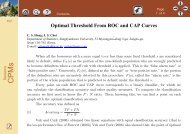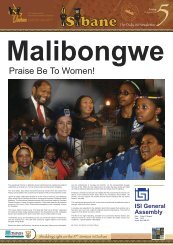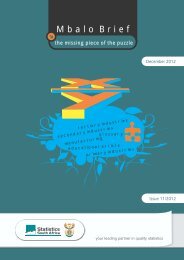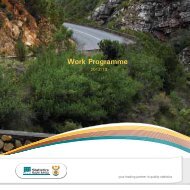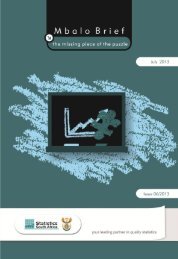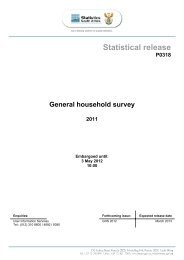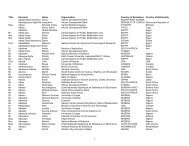Post-enumeration Survey (PES) - Statistics South Africa
Post-enumeration Survey (PES) - Statistics South Africa
Post-enumeration Survey (PES) - Statistics South Africa
Create successful ePaper yourself
Turn your PDF publications into a flip-book with our unique Google optimized e-Paper software.
<strong>Statistics</strong> <strong>South</strong> <strong>Africa</strong><br />
21<br />
4. MATCHING AND RECONCILIATION<br />
This chapter describes the methodology that was used to match census and <strong>PES</strong> records. It provides a<br />
summary of the activities that were implemented from the processing of questionnaires, initial matching,<br />
reconciliation visits and final matching.<br />
4.1 Data processing<br />
The processing of <strong>PES</strong> data was done by the Census Data Processing team and was completed in<br />
March 2012. This process involved the scanning of <strong>PES</strong> questionnaires in order to store the data in the<br />
form of electronic images and text files. The scanning of census questionnaires for the EAs that are in<br />
the <strong>PES</strong> sample, including surrounding EAs, were prioritised to ensure that both census and <strong>PES</strong><br />
questionnaires were made available in time for matching and reconciliation. The <strong>PES</strong> sample consisted<br />
of 600 EAs, but 596 EA questionnaire boxes were scanned for the <strong>PES</strong> since four EAs had been<br />
identified as out of scope after the completion of listing (three EAs had been identified as vacant and one<br />
as a special dwelling institution (SDI)). The Census Data Processing Centre (CDPC) handed over the<br />
data to the <strong>PES</strong> team in March 2012.<br />
4.2 Recruitment and training of staff<br />
Training on matching procedures<br />
Training on matching procedures was conducted over a period of one week. Theoretic training was<br />
carried out over a period of five days (12–16 March 2012) and practical training was conducted over a<br />
period of two days (17–18 March 2012) and was computer-based (on the computer-assisted manual<br />
matching system). Human Resource Management was requested to recruit 360 candidates in order to<br />
increase the pool of candidates to choose from (20% over-recruitment). 300 staff members were<br />
selected from a pool of 335 trainees upon completion of training as well as scores obtained for<br />
assessments administered during training. Candidates were expected to obtain an average score of 60%<br />
for all four (4) assessments administered during training in order to be considered for appointment. The<br />
300 candidates were appointed for the following positions:<br />
• 180 Matching Clerks,<br />
• 60 Matching Supervisors, and<br />
• 60 Quality Assurance Monitors.<br />
Training on reconciliation visit procedures<br />
Training on reconciliation visits procedures was conducted from 26–28 March 2012 in Pretoria. Training<br />
included a practical exercise on the use of global positioning system (GPS) devices to ensure that<br />
reconciliation visits are carried out within the correct <strong>enumeration</strong> area (EA) boundaries, and make a<br />
clear distinction between households that were correctly or erroneously enumerated (boundary-related<br />
inclusions/exclusions). The Reconciliation Visits team was made up of 27 staff members who had<br />
<strong>Post</strong> Enumeration <strong>Survey</strong> (<strong>PES</strong>)



